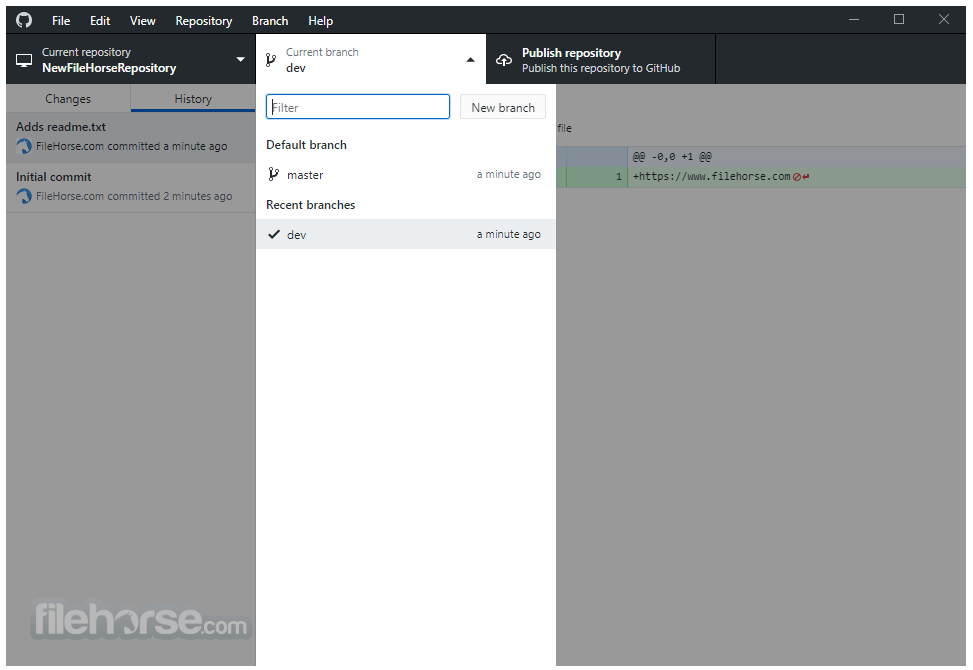

- #Github desktop proxy how to#
- #Github desktop proxy software#
- #Github desktop proxy windows 8.1#
- #Github desktop proxy code#
- #Github desktop proxy password#
Automatically used IE system settings fail. No settings to configure the Proxy in the GitHub Desktop. T14:43:56.795Z - error: git -c credential.helper= -c protocol.version=2 -c faultBranch=master clone -recursive -progress - C:\Repos\ConvertFRBtoABS exited with an unexpected code: 128.įatal: unable to access ' ': Unsupported proxy '10.0.2.1:3128', libcurl is built without the HTTPS-proxy support. T14:43:56.190Z - info: account found for remote: - diev (has token) Actual behaviorĬloning into 'C:\Repos\ConvertFRBtoABS'.įatal: unable to access ' ': Unsupported proxy '10.0.2.1:3128', libcurl is built without the HTTPS-proxy support. To get the repository cloned without error messages.
#Github desktop proxy windows 8.1#
Version 2.9.4 (圆4) & Microsoft Windows 8.1 Steps to reproduce the behavior Noting that many corporate firewalls block access to the CONNECT method on ports other than 443, the good folks at github have an ssh server listening on 443 if you use the host “ to clone a GH repository through a corporate http proxy fails. Proxycommand corkscrew 3128 %h %p ~/.ssh/myauth Each group produced Jupyter Notebooks and GitHub Discussions posts as. Open ~/.ssh/config and add the following entry, adding an explicit path to corkscrew if needed. The CryoCloud JupyterHub already had jupyter-remote-desktop-proxy and QGIS. Safeguard the file chmod 600 ~/.ssh/myauth
#Github desktop proxy password#
Now you can just say (for example): git clone gh:sitaramc/git-notes.git ssh proxy using corkscrew instead of socatĬreate a file (eg., ~/.ssh/myauth) and put your http proxy username and password as “username:password” in it and save it. Proxycommand socat - PROXY::%h:%p,proxyport=3128,proxyauth=user:pwd Ssh already has this sort of stuff built-in, so you simply add a few lines to your ~/.ssh/config host gh The git protocol is handled directly by git (duh!), but if you use the ssh protocol, it invokes ssh explicitly (again, duh!). I guess you could argue that this is a point in favour of corkscrew etc. Git passes the host and port as two arguments to the proxy command, but socat expects them in the syntax you see above, so you will need to wrap it in a script as I have done. One thing you cannot do is to roll the entire socat command into the environment variable.

you could give /tmp/gitproxy a more permanent name and remove the middle pararaph completely.bashrc that looks like this: proxied_git () To proxy the git protocol, you need to export an environment variable called GIT_PROXY_COMMAND, which contains the command that is to be invoked. When I want to download a public repo, I just type proxied_git clone. I don’t care since I don’t have anyone else logging into my desktop, and the ability to use a program I already have anyway (socat) is more important. However, do note that socat does have one disadvantage: the passwords to your proxy server are visible in to local users running ps -ef or something. The basic idea is that you will somehow invoke socat, which will negotiate with the HTTP(S) proxy server using the CONNECT method to get you a clean pipe to the server on the far side. I prefer socat, and once you spend the 2-3 years :-) needed to read the man page, you will see why! I will be using “socat”, an absolute corker of a program that does so many things it’s incredible! Other people use corkscrew, ssh-https-tunnel, etc., which are all specialised for just one purpose.
#Github desktop proxy code#
If you’re pushing code to a public repo, you definitely need to use the “ssh” protocol. If you’re tracking a public repo, you will need to use the “git” protocol, because the “http” protocol is not very efficient, and/or requires some special handling on the server side.
#Github desktop proxy how to#
ssh proxy using corkscrew instead of socatĬorporate firewalls and proxy typically block both of these (and often a lot more) here’s how to get around them.Gitolite documentation has another /gitolite in the URL, so "" and so ALL my git related stuff gets carried over. cms network at Point 5, but it should be simple to adapt them to other configurations.

The examples are valid for connections inside the.
#Github desktop proxy software#
That's just an artifact of "" being translated to Most often, connection problems occur because a firewall, proxy server, corporate network, or other network is configured in a way that blocks GitHub. CMS Offline Software Tutorial: how to use git through a proxy This tuturial will explain how to use git through a proxy, for example if you are behind a firewall or on a private network. How to use git over an HTTP proxy, with socatĪlthough this page has a "" URL, this is not about gitolite.


 0 kommentar(er)
0 kommentar(er)
